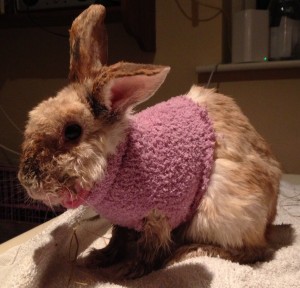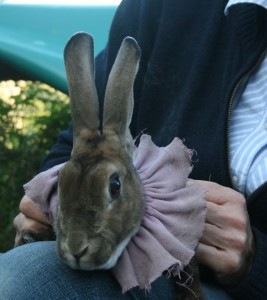Self-injury by rabbits is rare but not unknown. Over grooming can be found in rabbits that don’t have enough to chew, are kept without hay etc., and may develop into self injury. Usually fur pulling will cease if unlimited hay and chew toys are given as soon as possible. Light intensity may also lead to fur pulling (Blackmore et al., 1986, Srivastava et al., 2014). Fur pulling is also a normal part of nest building by female rabbits that have not been spayed. Hormone problems can also lead to fur loss (Geren, et al., 2021).
More serious is the rabbit that chews its feet or body producing real injury. It may start with an itch, then develop into compulsive licking/chewing. They can start biting themselves anywhere they can reach but the paws, particularly the front ones, are the most usual site. There may be a hereditary component to this behaviour in some rabbits (Igluaer et al., 1995). There is a useful article here http://www.disabledrabbits.com/self-injury.html and here http://www.medirabbit.com/EN/Skin_diseases/Mechanical/Mutilation/Selfmutilation.htm
Dental pain, or indeed any kind of bodily pain, can produce self harm. It is essential to have a really good veterinary check. Pooky-C, shown here wearing a pink knitted jacket to protect his skin from being chewed, was rescued when near death. His teeth had grown through his tongue splitting it in two, he was fed wrongly and his siblings all died. After veterinary treatment and good conditions, he regained some of his hair but eventually had to be put down to spare him further suffering. 
SYMPTOMS
Persistent chewing/licking by rabbit. There are patches of bare skin. The area chewed is wet. Blood on paws or bloody paw marks. Eventually the toes may drop off exposing long claws. Rabbit boxes the air or shakes its affected feet.
The vet needs to rule out underlying pain, atopy (allergy), contact allergy, foreign body reactions, skin parasites like mites or ringworm, pain, etc. (Harcourt-Brown 2002).
DIAGNOSIS
It may be any of the following:
Careful veterinary examination, blood tests, Xrays etc. These will rule out some of the possibilities. Make sure any possible causes like parasites are treated anyway.
TREATMENT
Depending on the cause, vets may use pain killers like metacam, antihistamines, steroids, antibiotics. Elizabethan or buster collars interfere with the rabbit’s need to eat its cecotrophs so are not appropriate. Surgery may be needed for the affected feet. Animals may need treatment for the rest of their lives. Occasionally, even when medication is continued, the animal starts attacking another foot. Like an addiction, it can break out again. Your vet may find the chapter on skin diseases helpful from The Textbook of Rabbit Medicine, by Harcourt-Brown, (2002).
Always make sure that your rabbit has plenty of good hay, plenty to chew, lots of toys, exercise, a bonded companion, is neutered and is not kept under bright light, or in very stressful conditions (Harcourt-Brown 2002). Good living conditions will enhance your rabbit’s life, even if they do not directly solve the self-injury problem.
If your rabbit continues to self harm, euthanasia may be the kindest option.
BAILEY – A CASE HISTORY WRITTEN BY SUE, HER OWNER.
“Bailey who is now just three, and Morag, her mother who is five or thereabouts are two rabbits who have lived with us since Bailey was seven weeks old. They were “rescue rabbits”, and both have been spayed. Bailey has always been very lively and inquisitive. When she was about 18 months old, we had noticed that when she was out in the garden, running round, she would suddenly stop and start gnawing her front paw, so vigorously that she sometimes fell over. I took her to the vet who checked her thoroughly and was able to exclude heart or ear problems or fits as the cause of falling over. She was also “air boxing” with her front paws at this time.
About six months on, I noticed faint bloody paw marks on the paper in the hutch where the rabbits sleep over night, and we had another trip to the vet. Both rabbits had all orifices and limbs checked and again we found nothing that could be the cause.
Six months after that, Bailey had been chewing at one of her hocks, which had blood pouring from it. The vet on duty said that she must have had a pressure sore on the hock: this was bandaged up and after a week the problem seemed to have been resolved. Then early in January of this year Bailey’s leg started to look all chewed again and we went back to the vet.
He gave her an anti-inflammatory injection but it seemed to make no difference – the leg got more chewed and it had started to turn black. This vet said that he thought the cause was “between the ears” but the leg was bandaged to try and protect it and let it heal up, and we gave Bailey regular doses of Baytril, to fight the infection. We kept both rabbits indoors and could see Bailey chewing at her leg most of the time, like a dog at a bone. In fact, we were rewarding the chewing behaviour, because we tried to distract her with food and attention when we saw her chewing. This was clearly a stressful time for her: one afternoon she had a little fit and we took her along to the vet for a check up and an “all clear” but by evening GI stasis had set in.
Four days later she had another very serious bout of GI stasis and we were starting to wonder what her quality of life was like. She pulled through that and her leg started to heal up a bit, although we still didn’t know what the cause was. Her leg was mending slowly and, on one of our check ups, one of the vets who had been treating Bailey produced a magazine. It was a copy of “New Direction” that had just come into the practice and included an article about self-mutilation in rabbits . The vet discussed the article with us, and we were offered Metacam for Bailey. We changed their accommodation, too. We don’t know whether it was the medication or the change of accommodation, or a combination of the two factors but for the past six months, Bailey hasn’t chewed herself.
COMPULSIVE LICKING – A CASE HISTORY
 This is Brodie, a seven year old rabbit who started repeatedly to overgroom her dewlap, taking off the hair and the flesh. Her living conditions are good – a companion, unlimited hay, good amount of space.
This is Brodie, a seven year old rabbit who started repeatedly to overgroom her dewlap, taking off the hair and the flesh. Her living conditions are good – a companion, unlimited hay, good amount of space.
The behaviour started when Brodie was 18 months old. Roseanne came back from a few days away to find the dewlap red and sore. The vet checked for mites or other parasites and found nothing. He could not suggest any strategies. He warned that if the area became chronically infected, euthanasia would be the only answer.
“I had to do something,” says Roseanne. She experimented with a bib, one that goes right round the neck otherwise the rabbit would simply push it to one side and continue overgrooming. She makes each bib herself. It is soft material (not nylon because it is chewed) with a tape drawstring round the neck. The knot has to be under the bib otherwise Brodie chews the tape. Luckily Roseanne knows about dressmaking. She has experimented to get the bib long enough to cover the dewlap, yet short enough for Brodie to groom the rest of herself and reach round to eat her caecotrophs.
Set backs have occurred when Brodie started overgrooming her stomach too. Roseanne lengthened the bib and made Brodie a T-shirt to cover the area. Then Brodie started overgrooming her sister too, to Roseanne made another T-shirt for her sister. Luckily both these behaviours have currently ceased. The bib allows Brodie much more movement, the ability to groom part of herself and reach her bottom to eat the cecotrophs – a traditional Elizabethan collar would not do this. It is humane and practical. Rabbit owners with a similar problem may like to try this if veterinary treatment cannot cure the problem.
REFERENCES
Beyers, T. M. (1991) ‘Axonal degeneration and self-mutilation as a complication of the intramuscular use of ketamine and xylazine in rabbits,’ Laboratory Animal Science, 41, 519-520.
Blackmore, D. K., Schultze, W. H. & Absolon, G. C., (1986), ‘Light Intensity and Fur Chewing in Rabbits,’ New Zealand Veterinary Journal, 34, 158.
Geren, J. , Kilson, K. & van Prag, E., ‘Bilateral symmetrical alopecia is sporadically observed in male and female rabbits.’ Available from www.medirabbit.com. Downloaded June 2 2021.
Harcourt-Brown, F., (2002), The Textbook of Rabbit Medicine, Oxford, UK, Butterworth-Heinemann.
Igluaer, F, C. Beig, J. Dimigenl, S. Gerold, A. Gocht, A. Seeburg, S. Steier & F. Willmann, 1995, ‘Hereditary Compulsive self-mutilating behaviour in laboratory rabbits.’ Laboratory Animal, vol 29, 385-393.
Srivastava, M., Ahuja, A., Kachhawaha, S., Singh, N. K., Sharma, A & Kachhawa, J. P., (2014), ‘Stress Induced Acral Lick Dermatitis in a Domestic Rabbit: A Case Report,’ Case Reports in Veterinary Medicine, http://dx.doi.org/10.1155/2014/142813
Vachon, P., (1999), ‘Self-mutilation in rabbits following intramuscular ketamine-xylazine-acepromazine injections, Canadian Veterinary Journal, 40, 581-582